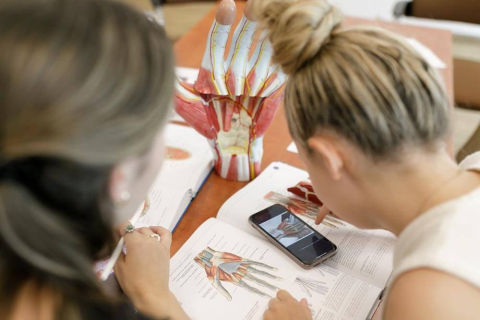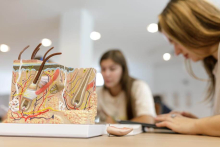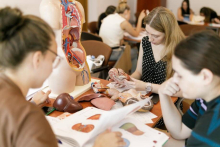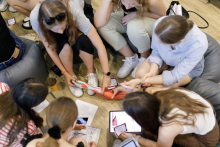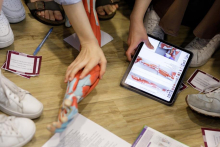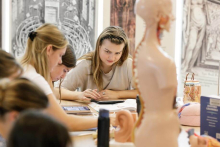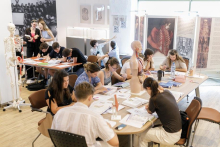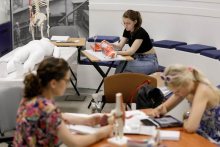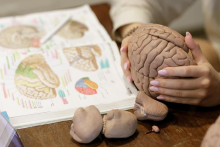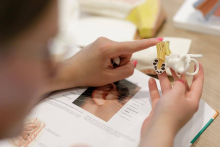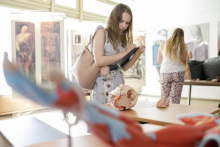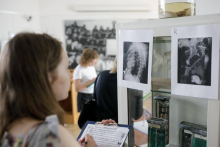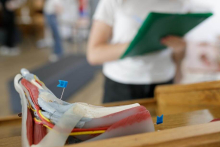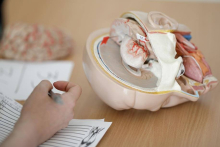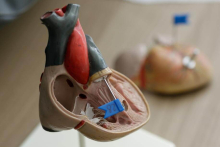“Pins” is a colloquial name for a practical exam on anatomy, during which students must recognize anatomical structures of the human body marked with pins on a model. The participants of the “Anatomy Refreshment” could take this pre-exam and more than 300 took advantage of this opportunity. “We tried to make this simulated exam as much realistic as possible to allow students to prepare well for the real one,” said Kinga Dziobiak, a member of arsMedica who hosted the event. First, students were expected to identify so-called “base points” in anatomical structures. They then moved on to recognizing more complex ones. They also had to name them in English and/or Latin. At the end, radiological pins were waiting for the participants.
The students could also listen to mini-lectures presenting the most important parts of the human body. They could use textbooks, atlases and an accurate and advanced set of anatomical models. One of them was an interactive phantom mapping six human anatomical systems. The phantom is an element of the modern educational space of the Museum of the History of Medicine of the Medical University of Warsaw: the “Anatomical Theatre of the 21st century”. ArsMedica members also prepared many materials of their own, which in a less routine way allowed for the consolidation of knowledge. The learners could therefore play, for example, the “Pack a suitcase” game – in which they tested their knowledge about vascularity, innervation and muscles of the palm and forearm by packing appropriate “pieces” – or take part in the challenge of drawing the brachial plexus.
The “Anatomy Refreshment” is a continuation of the educational project started in June by students from ArsMedica and by the Museum of the History of Medicine of the Medical University of Warsaw. In June, everyone preparing to pass the anatomy exam could take part in the “Anatomical Warm-up” arranged for in the premises of the Museum. “The idea for such meetings for students arose during the pandemic because of which my class have missed many lessons in the dissection room. Together with my friends, we wanted to set up a community that would support one another in learning, as well as expand anatomical knowledge and practice more with the pins,” said Kinga. The idea was discussed with the Head of the Department of Normal and Clinical Anatomy of the Medical University of Warsaw and the Director of the Museum of the History of Medicine and gained their approval and support. Most students come to the “Warm-up” and the “Refreshment” primarily with a view to passing the exam. Then they realize that anatomy is a very interesting field. “Anatomy is a science that is engaging and really necessary, whether you are a medical student or have another profession. Our meetings are to use knowledge gained during lectures, get to know other people and catch the anatomical bug,” added Kinga.
The “Warm-up” and the “Refreshment” were supervised by Dr. Mikołaj Sługocki from the Department of Normal and Clinical Anatomy. The anatomical models were provided by the Museum, the Library and the Department of Normal and Clinical Anatomy of the University. The whole event took place in the premises of the Museum. “We are glad that we are able to offer students an environment to learn without disruption, using state-of-the-art learning aids.” said Grażyna Jermakowicz, Director of the Museum and one of the hosts of the event. She added that that everyone who wants to learn something about anatomy may take part in very interesting classes delivered at the Museum, in the aforementioned “Anatomical Theater of the 21st century”.
